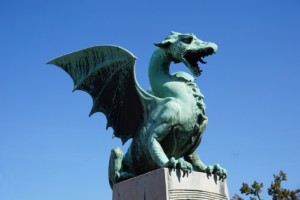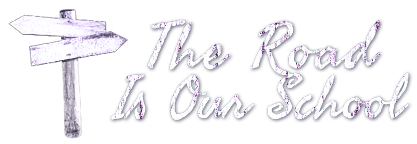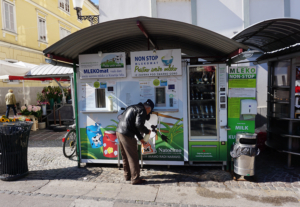Ljubljana – Oct. 3-7
By Leyla
Arriving in Ljubljana at 2pm, our host Martina met us at our sun-filled apartment, which turned out to be on the same street as the beautiful historic buildings that house foreign embassies, and directly across the street from the Presidential Palace! The first thing we did after unpacking is to sign up on-line for Bicikelj – Ljubljana’s bike sharing system. Based upon the ease of signing up, the system appears to be way more user friendly than Velib in Paris. Firstly, it is much less expensive – 1 euro per week instead of 15 E per week and 5 Euro per day in Paris. Also in Paris you ride free for 30 minutes after which you need to find a station and trade in your bike, whereas in Ljubljana it’s 1 hour and the charge for the second hour is only 1 Euro. And while there are less stations, it’s also a smaller City and all the bikes and the stations worked, unlike in Paris.
We booked a free bike tour we found on Trip Advisor figuring this was a great way to get acquainted with the City so we met our guide, Jan, on the steps of Preseren Square. Another thing we have learned about Slovenia is that their statues and memorial squares are not dedicated to war heroes or leaders, but to poets and artists. Preseren is a poet who wrote a wedding toast and many decades later, a paragraph of that toast, became the nation anthen. Not only is the anthem unique because it speaks to love of drink, the beauty of Slovenian women, the strength of Slovenian men and the nature that abounds, it wishes the peace and prosperity to other nations, along with Slovenia.

Ljubljana’s main square is named after its poet France Prešeren. Here his muse aims to swat a pesky pigeon from his head.
The tour was with Jan, a young man who served in the army He go the idea in May when he went on a similar tour in Rome so he got some bikes and set up his business in June. He took his bikes to his home town of Maribor at the end September but nevertheless decided our family of 3, when we inquired. We ended up taking City bikes and riding around the perimeter of the City Center. He took us first to Metelkova Mesto the artsy alternative culture spot of Ljubljana. Once Yugoslavian army barracks, the place was taken over in the early 90s by squatters (many of whom still reside here), who proceeded to create art installations and decorate the cement block buildings with graffiti. This was not only condoned, but is now funded by the City government and is a place where people of all ages come for concerts, coffee and beer, all at very cheap prices. Jan explained that the shoes hanging from the electric wires signify this as a place to buy drugs and, indeed, we were asked several times if we needed any. We visited Tivoli, the large City Park and a few other landmarks before it became too dark to ride and we parted at Preseren Square.
It was now time to meet Angie, Janko, and 14-year old Tia. When Kai Schuler of Telluride heard we were going to Slovenia she introduced us to her Slovenian friends, who she had met when they were all traveling in Cuba, and with whom she kept up with via Facebook. It was so thoughtful of Janko to bring his daughter, Tia as a companion for Emily. Advising them of Emily’s love of sauerkraut, they lead us to the very restaurant we had passed earlier where Emily had spied an appetizing dish of sausage with kraut. It was great to hear their stories and to spend time talking with locals. After our daily gelato fix at Vigo, the best ice cream place in Ljubljana, we stopped for more craft beer and drinks and then walked back to our very sweet apartment.
The next day we had a walking tour planned at 11am, meeting again at Preseren Square. But first a quick peruse of the open-air market, where we saw lots of farm fresh fruits and vegetables. Our tour guide Ana, offered a very clearly articulated review of the history we had already learned about Slovenia in our travels, starting with Jason and the Argonauts, to the Roman Empire, the Austro-Hungarian Empire, Communism under Tito and ending with Slovenian independence from Yugoslavia. She underlined the main point of recounting this history, that is, while Slovenia has only been a country for 27 years, it has been a nation for centuries. The people of this nation have a proud identity and heritage and they love their poets, their artists and their architects. They also don’t bury away some of the less proud moments in their history – instead they depict them in bronze on the doors of the cathedral to remember and reckon with their past. The doors show the history of the Slovenian people through the centuries and one of the images is of the lost and despairing. According to Ana, during WWII and the occupation by the Italian Fascists and the German Nazis, most Slovenians resisted, but those who were believed to be collaborators were executed after the war. And the fact that this was done without due process or a trial, still weighs heavy on the hearts of the Slovenian people.
We also learned a great deal about Jose Plecnik, Ljubljana’s beloved early and mid 20th century architect who thoughtfully shaped Ljubljana’s public places. He is the one responsible for the 3 bridges from Preseren Square to the market square and the town square on the other side of the river. Ana explained that when Plecnik was commissioned by the City to enlarge the main bridge at the center of the City, at a time in the beginning of the early 1900s when trams, cars, horse drawn carriages and pedestrians all had to share the crossing, rather than expand the bridge, he built to bridges on either side of it, leaving the middle one for motorized vehicles. Now, there are no motorized vehicles on the middle bridge because within the past 10 years, the current Mayor, up for his 4th term in November, made the bold move of creating a vehicle-free zone in the center of the City, where only pedestrians, bikes and the occasional City run electric golf cart style vehicle are allowed. We learned that Plecnik also designed a 300-meter long Roman inspired building along the river to house the covered market place that he miraculously completed under Italian occupation during WWII. During this same period, he designed and built the National Library. The entry of the library is dark, with skinny aisles made of dark-colored wood that then gives way to an open, light-filled reading room. According to Ana, Plecnik wanted to signify that with reading, and education, comes the light i.e. enlightenment. We also saw the entrance to the magnificent building housing the administrative offices for Slovenia’s oldest and most distinguished national University, where education for all, including foreigners, is free. We first learned this in Michael Moore’s film “Who Do We Invade Next”. This is what inspired us to learn more about Slovenia, culminating in our visit. We learned from Ana that not only is education free for all, but the government gives students coupons to eat at any restaurant (which are already very affordable) for half the price.
 The dragon is Ljubljana’s protector. According to legend, Jason and the Argonauts were the first settlers, ending up here after evading those pursuing them when they stole the Golden Fleece. They traveled from the Black Sea to the Danube and then the Sava River to the swampland that was then Ljubljana. It is here that Jason fought and wounded the dragon of the swamp. Clearly, something is protecting Slovenia and allowing its people to live in relative peace and prosperity, with an abundance of diverse nature, and some of the cleanest water and air in the world. During WWII, the country was somehow spared the bombing that neighboring countries received. After WWII, Tito somehow kept Stalin at bay, so that Yugoslavia was never part of the Soviet bloc, like Poland and Czechoslovakia, and had a far less rigid form of communism, with more freedom and a better economy. And when 89% of Slovenians voted in a referendum to declare their independence from Yugoslavia in 1991, somehow, their war lasted only 10 days before a peace treaty was signed and the new country acknowledged by other countries in the world. Meanwhile, Croatia, Serbia and Bosnia fought a devastating war that lasted years.
The dragon is Ljubljana’s protector. According to legend, Jason and the Argonauts were the first settlers, ending up here after evading those pursuing them when they stole the Golden Fleece. They traveled from the Black Sea to the Danube and then the Sava River to the swampland that was then Ljubljana. It is here that Jason fought and wounded the dragon of the swamp. Clearly, something is protecting Slovenia and allowing its people to live in relative peace and prosperity, with an abundance of diverse nature, and some of the cleanest water and air in the world. During WWII, the country was somehow spared the bombing that neighboring countries received. After WWII, Tito somehow kept Stalin at bay, so that Yugoslavia was never part of the Soviet bloc, like Poland and Czechoslovakia, and had a far less rigid form of communism, with more freedom and a better economy. And when 89% of Slovenians voted in a referendum to declare their independence from Yugoslavia in 1991, somehow, their war lasted only 10 days before a peace treaty was signed and the new country acknowledged by other countries in the world. Meanwhile, Croatia, Serbia and Bosnia fought a devastating war that lasted years.
In the afternoon, Angie and Janko offered to take us on a hike up the local mountain and to the tavern on top, that serves affordable Slovenian food. This is the other feature of Slovenia worth noting is that where ever you would expect tourist prices and bad tourist food, the prices are very reasonable and the food outstanding. In other words, if Slovenia had invented Disneyland, the food would be outstanding and the prices reasonable. Slovenians are often tourists in their own country and it’s clear they don’t stand for gouging or bad food.
It was a warm day and we started shedding layers immediately – about the same time the bottle of Schnapps and the small plastic shot glasses came out of Janko’s backpack for a pre-hike toast! We had seen locals throughout Slovenia carrying a glass bottle on their hikes and now we were with locals, doing the same. We learned that both Janko and Angie’s parents had farms in the south of the Country, near Zagreb, and they had spent the last few months trying to keep up with the bumper crop by canning, dehydrating, making marmalades and distilling fruit liqueurs and schnapps. Janko said his father’s makes Pear William Schnapps and treats the pears in his orchard like his babies – turning them toward the sun on the branch and lovingly caring for those that fall to the ground.
At the top, we were graced with panoramic views of Ljubljana and the surrounding area. At the tavern, lots of locals were sprawled out with shirts off on deck chairs, taking in the sun. It was like an après-ski scene in March. We sampled some local favorites including the Jota soup we had come to love, with side plates of sausage, sauerkraut and buckwheat meal all topped of with the signature desert comprised of layers of milk cream, walnut cream, apple cream and poppy seed cream with puff pastry. Not sooner were we down the mountain, than Janko proposed coming to a café their house for Pivo and more Schnapps. I was just getting over a cold, so Emily and I went home while Mark spent the evening with our wonderful new friends, coming home laden with gifts: apples from the family orchard, and of course, a beautiful glass bottle of Schnapps.
Our next day in Ljubljana was meant for exploring Ljubljana aimlessly on bikes and on foot. It was another warm, sunny day so we started at the farmers market, spying wild strawberries and juicy flavorful raspberries, along with Kaki, or persimmon, which we had seen growing on trees near Piran and in the Vipava Valley. There was big bunches of freshly harvested Kale – all kinds, along with 6 types of lettuce mix, arugula and radicchio for salad. Even though eating out in Slovenia had been such a delightful experience, we could not resist getting some berries and greens to take home. We also saw milk and cheese machines at the open market, dispensing farm fresh raw milk and cheeses, delivered daily to the machine by local farmers, and sold for pennies. We also visited the covered market where meats, grains, nuts and cheese are sold.
Next, we got on our city bikes for a ride down the river to “the beach”, a peninsula at the fork of the river – another low-key après-ski style hangout spot, where one could rent paddleboards, kayaks, canoes etc. We knew already our destination for a late lunch – back to the open market for Friday’s open kitchen, where street food vendors cooked up an international array of foods. Mark and Emily went for African and Turkish, while I went for Mussels cooked in white wine and garlic in a huge wood fired skillet. And the wine was flowing freely with vendors giving customers white and red stemmed glass wine glasses with no deposit and no open container laws. Janko had asked Mark the previous day if it was really true that in the U. S. we were not allowed to walk the street enjoying an open alcoholic beverage. We then walked up the hill, along charming historic alleys and secret lanes, up to Ljubljana’s Castle to see the sunrise. Beautiful! Then back to open kitchen for Pad Thai to go to eat at home in our sweet apartment, leaving to stroll again to get ice cream. Emily noticed that Vigo had the distinction of being the “runner up” for best ice cream so we had to find #1. We had a suspicion it was Cacao. It was. My mascarpone and dried fruit gelato was good but I felt something in my mouth that was not dried fruit. Turns out it was part of my tooth. This is what comes of eating ice cream on a daily basis! Back at home, after writing an e-mail to my dentist in Boulder, I googled schools in Ljubljana, discovering that there is a public IB school called Danile Kumar, named after a female resistance fighter killed in WWII. I also found a 25+ year-old Waldorf School that goes through High School. The next morning, with rain in the forecast for the afternoon, after another stop at the open-air market, to ride bikes to the Waldorf School because it was downtown, abutting the hill side under the castle opposite from the one we explored the day before. We expected only to see it on the outside but saw people coming on the door, so went inside to discover they were hosting a weekend teachers’ conference for the Waldorf Schools in Slovenia and Croatia. The main room where the teachers were enjoying lunch was amazing. The ceiling was made of brick and formed into arches, resembling a monastery. We were pointed to Vera, one of the original founders of the school, who graciously chatted with us, answered all our questions/ She said the lower classes were all full to the brim but there was room in the upper grades and welcomed Emily to join the school, advising that Emily would be in level 9, the last grade of primary school. She invited us to tour the school. The building is four stories tall, with an acoustically attuned gym on the lower level, classes on the upper two levels, art and wood working classes on the top floor, and an entire wing we did not see. It felt really good!
We came home for lunch and then headed to the Museum of Illusion, where we spent the rainy afternoon, returning home for another home prepared meal and to pack for our departure to Graz, Austria the following morning.
Track Us Down
Leyla, Mark & Emily



